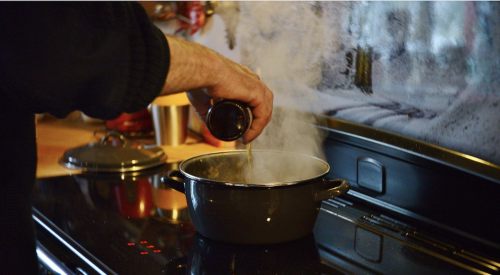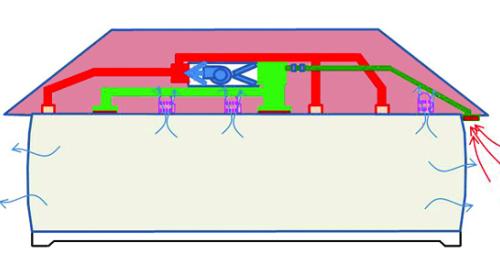New home. Fresh start. Clean living — right? Not necessarily, if you heed the Environmental Protection Agency's warning that the air inside homes can be more polluted than the air outside — even in the largest and most industrialized cities.
 The following contribute to a healthy indoor environment: 1. Select materials with low VOCs. 2. Size the HVAC system properly and design it to correctly filter and ventilate the air and control humidity. 3. Use building envelope best practices to keep the home water-tight. 4. Seal combustion appliances so that burning by-products cannot backdraft into the home. 5. Instruct owners on maintaining quality air after your job's done. |
But your new homes can offer cleaner living with proper design, material specification, construction and maintenance. PATH offers its Indoor Air Quality Tech Set as a how-to guide for designing, controlling and maintaining proper IAQ.
Too much air sealing and not enough controlled ventilation can cause contaminants to build up.
Water condensation on the interior of windows, musty odors, stuffy air, dirty registers, return air grills, mold, mildew and homeowner discomfort are all signs of a possible IAQ problem. But by the time those signs appear, the problem is already there.
It's much less expensive in the long run — and better for your firm's reputation — if those problems never develop.
VOCs include a wide range of compounds that contain carbon and other elements, such as hydrogen, oxygen, fluorine, chlorine, bromine, sulfur or nitrogen. They evaporate easily at room temperature, often have a sharp smell and may be detrimental to your health.
Plywood, most OSB sheathing and many carpets, conventional paints, finishes, glues, stains, sealers and plastic-based products contain high levels of VOCs that produce potentially harmful gasses when applied.
Today, low- and no-VOC products are available almost anywhere. Also, low- and no-VOC latex paints use water as their solvent and carrier, which eases cleanup and is generally less toxic. Note, however, that not every latex-based paint is low in VOCs.
To control indoor air effectively, the HVAC system should be custom-designed for each home you build.
Don't rely on rule-of-thumb sizing, which often results in a costly and drafty system that delivers too much air conditioning and uncertain humidity control. Look to ACCA's Manual J to get the right size system.
Ventilation may be as simple as installing well-placed spot ventilation fans that augment the space heating system or control bathroom moisture.
Or you may need to integrate whole-house ventilators and humidity control to provide a measured amount of outdoor air for conditioning at regular intervals. Don't rely on air leaks to deliver outdoor air.
All HVAC systems contain some method for filtering the room air that is returned to the unit for re-conditioning. The sizes of particulates that filters can trap varies, as does their ability to filter moisture and sterilize micro-organisms. Generally, the better the filter, the more expensive it is, although even a high-quality filter won't cost much at your local home improvement store.
Some filtration methods can be implemented by switching to a different filter medium, while others require special housing. If you use a special filtration system, verify with your HVAC designer and supplier that it is compatible with the furnace, air conditioner and air handling units. Otherwise, system performance will be compromised.
Since HVAC system maintenance and filter replacement should be performed at regular intervals, make these areas easily accessible.
All outdoor air intakes should be at least 10 feet away from exhaust outlets and areas where vehicles idle.
Test for radon. If you find it, there are simple construction techniques that will mitigate this dangerous gas. Find a local radon remediation subcontractor to conduct this work.
A well-built home repels moisture and air with good design features like covered entries, redundant weather barriers and grading that moves water away from the structure. Follow the steps outlined in PATH's Tech Set 2, Durable Building Envelope, to eliminate water leaks, which can lead to mold and damage structural integrity.
In homes with attached garages, completely seal the boundary between the home and garage. Connecting doors between the garage and living space should be gasketed and weatherstripped. Attached garages should have a 100 cfm exhaust fan continuously venting outdoors.
Heating equipment that burns any fuel that relies on an open flame inside the home should be vented outdoors. Seal the vent per manufacturer recommendations so that burning by-products, such as carbon monoxide, cannot come back into the home through wind currents or unbalanced ventilation.
Install a kitchen exhaust fan over the stove and oven — and especially over a gas-fired grill — to vent cooking odors, moisture and combustion by-products.
While quality building practices make a huge difference, the occupants of the home control the quality of their indoor air long after the builder is gone. Remind your buyers to close the windows while mowing the lawn; wash and brush pets regularly and do so outdoors; control insects and pests indoors; wipe or remove shoes worn outdoors upon entering the home; and regularly dust, damp mop and vacuum. Now you can breathe easy, knowing you've done all you can to help your customers breathe easy too.
![]()
| • Find the PATH Tech Sets at pathnet.org. Click on “Tools.” • Visit PATH’s Technology Inventory at toolbase.org for a detailed description of innova-tive technologies that can help improve indoor air. • Learn more about indoor air quality at epa.gov/iaq. |
| Author Information |
| Glen Salas writes about better building practices on behalf of the Partnership for Advancing Technology in Housing which is administered by the U.S. Department of Housing and Urban Development. Learn more at www.pathnet.org. |












